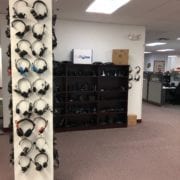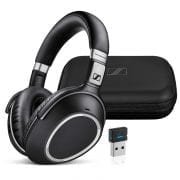ANC Headsets for Business Collaboration
Active Noise Cancellation (ANC) technology in business headsets became increasingly popular during the global pandemic as the multitude of traditional in-office workers transitioned to work from home. The home environment introduced sources of noise not often found in offices like doorbells, barking dogs, blenders, and screaming children. Today organizations are making plans that will include the return to the office, remote work, or hybrid work.
In addition to having a strong noise-canceling microphone, headset wearers have found they want to suppress the background noise they hear so they can focus on their work.
Some headsets offer Passive Noise Reduction and some offer Active Noise Canceling (ANC). ANC is the stronger of the two. However, not all ANC speakers function the same. According to Jabra’s blog “ANC headsets aren’t all the same: The three types of ANC”, the three types of ANC are feedforward, feedback, and hybrid. The hybrid approach works best but costs the most. Jabra also states aside from the ANC technology itself, there’s a matter of how the headset is designed.
Compatible with Business Collaboration Platforms
ANC headsets used for business, need to be compatible or certified with the collaboration platforms being used like Microsoft, Zoom, Cisco, Genesys, AWS, 8×8, RingCentral, and more. Leading headset manufacturers will often include a USB dongle to be used with their ANC Bluetooth headsets. Our customers and YouTube viewers frequently ask, “Why do I need a USB dongle?” With the help of our partners, we provide reasons in this blog: “Why Do I Need a USB Dongle vs Pairing the Headset Directly to a Computer?” The primary reasons to use the dongle are compatibility, connection stability, and call control (answer/end, mute, volume up/down) from the headset vs using your mouse.
Microsoft Teams certified models will work with no extra configuration required and offer call control with Microsoft Teams and Skype for Business. The dedicated Teams button and LED indicator light will provide user notification of events and alerts from the Teams client: Meeting starting, voicemail, or missed call. You can also activate the Teams client or respond to notification with a press of the button i.e. to join a meeting.
Wearing Styles
Today there are multiple headset wearing styles that include ANC technology to support the wide range of personal preferences. Some folks prefer having both ears completely enveloped by the speakers. Others prefer the more discreet earbud-wearing style. And, some wearers prefer a headset with a boomless mic.
DECT Wireless ANC Headsets


Savi 8220 Headset Side View 

Savi 8220 Headset Rear View
The majority of headsets that offer ANC speakers are Bluetooth. If you require a DECT wireless headset with ANC speakers, the Poly Savi 8220 stereo models are a great option. The Poly Savi 8220 are available in Office and UC variants. The Savi 8220 Office series support connectivity to desk phone, computer, and mobile device. The Savi 8220 UC includes the D200 DECT Dongle for computer-only connectivity. The D200 is available in USB-A UC, USB-A Microsoft, USB-C UC, and USB-C Microsoft. I’m not aware of another business-grade DECT headset with ANC.
Corded ANC Headsets

The Poly Blackwire 8225 Series are corded USB headsets available in USB-A, USB-C, and Microsoft Teams variants. Not only do you get ANC speakers, but you also get Poly’s Acoustic Fence technology built into the microphone so the people you’re speaking with don’t hear the noise around you. If you prefer a boomless mic corded USB option, take a look at the Poly Blackwire 7225 Series. If you prefer to have your ears completely enveloped, the Jabra Evolve 80 Series may be a good choice for you. The Jabra Evolve 80 offers USB-A connectivity as well 3.5mm for select mobile devices. They are available in UC and Microsoft variants.
Bluetooth ANC Headsets with Boomless Mic

In October 2020, we released a video comparing four heavy hitters in the Bluetooth ANC headsets with boomless mic space. It included the Bose 700 UC, EPOS Adapt 660 UC, Jabra Evolve2 85, and Poly Voyager 8200 UC. Watch the video! Bose vs EPOS vs Jabra vs Poly | Which Headphones Sounds the Best? Other available options are the Cisco 730 available in Platinum or Carbon Black. EPOS also has lower-cost options with their EPOS Adapt 560, EPOS Adapt 563 (for mobile only), and EPOS Adapt 360 models in black or white.
In-Ear Behind the Neck ANC Headsets
For folks looking for a sleeker form factor, you have these behind the neck options: Jabra Evolve 75e UC or Microsoft variant, Poly Voyager 6200 UC with USB-A or USB-C dongle, and EPOS Adapt 460T.

Voyager 6200 UC Black 
EPOS Adapt 460T
What to look for in ANC Headsets
I test a lot of headsets. Typically I’m testing the microphones to see how well they perform in real-world environments. Take a look at this Headset Mic Test Video Playlist on our YouTube Channel. Plus, I use headsets daily for communicating and collaborating with colleagues, customers, and partners. I’ve used them in the office, on the road, in airplanes, and from my home office. Here are the variables and factors I considered when selecting my top ANC headset picks for business collaboration:
Danny Hayasaka’s Top ANC Headset picks are:
These two headsets have been solid performers. The Poly Voyager Focus 2 is newer but it very quickly became a favorite based on all the above factors. The Jabra Evolve 75 has been a long-time favorite of mine. Take a look at this Voyager Focus 2 vs Evolve 75 comparison video.

Which headsets have the best ANC?

Conclusion
ANC headsets are a great option for Hybrid Work which translates to Work from Anywhere. The need to block out distractions so you can focus on work or enjoy streaming music can be satisfied with a headset with good ANC speakers. We have created a page that lists all the current ANC Headsets by Brand (Poly, Cisco, EPOS | Sennheiser, Jabra, & Logitech). If you would like guidance or need mass deployment support regarding ANC Headsets for Business Collaboration, contact us! We are more than happy to help you do your business better!

























 Every day I hear customers requesting “ANC” or “NC” headsets. Some know the difference however many don’t. It’s kind of like “Bluetooth”. To some, “Bluetooth” simply means “wireless”. Whether it’s DECT, 2.4Ghz, 900Mhz is irrelevant to them. They want a “Bluetooth (Wireless)” headset. For this blog, I’m talking about headsets for professional use by Poly (formerly Plantronics), Jabra & Sennheiser.
Every day I hear customers requesting “ANC” or “NC” headsets. Some know the difference however many don’t. It’s kind of like “Bluetooth”. To some, “Bluetooth” simply means “wireless”. Whether it’s DECT, 2.4Ghz, 900Mhz is irrelevant to them. They want a “Bluetooth (Wireless)” headset. For this blog, I’m talking about headsets for professional use by Poly (formerly Plantronics), Jabra & Sennheiser.

